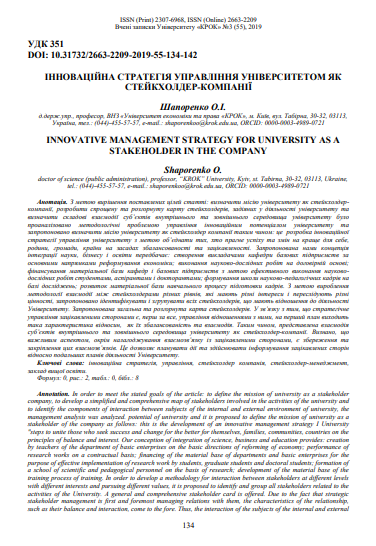INNOVATIVE MANAGEMENT STRATEGY FOR UNIVERSITY AS A STAKEHOLDER IN THE COMPANY
DOI:
https://doi.org/10.31732/2663-2209-2019-55-134-142Keywords:
innovation strategy, management, stakeholder company, stakeholder management, institution of higher educationAbstract
In order to meet the stated goals of the article: to define the mission of university as a stakeholder company, to develop a simplified and comprehensive map of stakeholders involved in the activities of the university and to identify the components of interaction between subjects of the internal and external environment of university, the management analysis was analyzed. potential of university and it is proposed to define the mission of university as a stakeholder of the company as follows: this is the development of an innovative management strategy I University "steps to unite those who seek success and change for the better for themselves, families, communities, countries on the principles of balance and interest. Our conception of integration of science, business and education provides: creation by teachers of the department of basic enterprises on the basic directions of reforming of economy; performance of research works on a contractual basis; financing of the material base of departments and basic enterprises for the purpose of effective implementation of research work by students, graduate students and doctoral students; formation of a school of scientific and pedagogical personnel on the basis of research; development of the material base of the training process of training. In order to develop a methodology for interaction between stakeholders at different levels with different interests and pursuing different values, it is proposed to identify and group all stakeholders related to the activities of the University. A general and comprehensive stakeholder card is offered. Due to the fact that strategic stakeholder management is first and foremost managing relations with them, the characteristics of the relationship, such as their balance and interaction, come to the fore. Thus, the interaction of the subjects of the internal and external environment of university as a stakeholder company is presented. It is recognized that an important aspect, besides establishing stakeholder engagement, is maintaining and securing these relationships. This allows for planning of actions and keeping stakeholders informed of further plans for the University.
Downloads
References
Аммарі А. О. Класифікація стейкхолдерів на основі взаємних очікувань. Актуальні проблеми економіки. 2012. № 8. С. 150-155.
Базалиева Л. В. Методические аспекты формирования доверительных взаимоотношений предприятий со стейкхолдерами. БІЗНЕСІНФОМ. 2017. № 4. С. 376-381.
Борисанова Д. А. Организация взаимодействия со стейкхолдерами в процессе проектирования образовательной среды сетевых образовательных программ. Методист. 2016. № 5. С. 26-30.
Ильюк В. В. Методологический подход к управлению стейхолдерами инновационных проектов. Организатор производства. 2016. № 4. С. 38-51.
Нуждин Р. В., Полозова А. П. Бизнес-анализ возможностей стейкхолдер-менеджмента в достижении положительной синергии. Вестник ВГУИТ. 2016. № 4. С. 437-445.
Солодухин К. С. Стратегическое управление ВУЗом как стейкхолдер-компанией: научное пособие. Москва : Политехн. ун-та, 2009. 290 с.
Федорів Т. В. Співвідношення понять «стейкхолдери», «аудиторія», та «громадськість» та їх зв’язок з репутацією органів державної влади. Економіка та держава. 2013. № 3. С. 121-123.
Фисенко Т. С. Практика организации взаимодействия со стейкхолдерами по созданию развивающей образовательной среды. Методист. 2016. № 6. С. 23-30.


